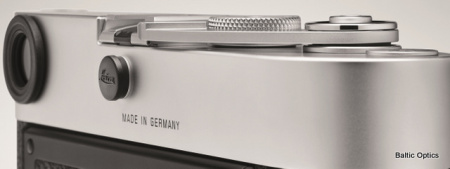4 950 €
Article:
10371
In stock:Not available
By order
Our managers will contact you and clarify the terms of the order
The price is valid only for the online store and may differ from the prices in retail stores.
Need a consultation?
Our experts will answer to any question
Ask a question
Description
As a purely mechanical camera, the Leica M-A is a precision instrument that has been so dramatically reduced to the essentials that it opens up entirely new creative horizons for photographers. It may have no monitor, no exposure meter, and no battery, but what it does have is a mechanical quality that makes Leica’s 100 years of experience instantly tangible. Photographers can read the shutter speed and aperture directly from the camera and lens and so concentrate fully on their subject. The acoustic signature of the shutter release of a Leica M-A is a delight that immediatelyю reveals the precision-engineered excellence of its origin.
The exterior of the Leica M-A is as timeless as the precision engineering hidden inside. For instance, the Leica red dot has been deliberately omitted to emphasise the classic restraint of its design as an ultimate expression of understatement. Viewed from the side, the M-A is also noticeably slimmer than its digital counterparts.
The camera is available in two different finishes: the classic look of the silver chrome version continues the design tradition derived from 60 years of Leica M-Cameras. In the black chrome option, the M-A is reminiscent of the style of the M Monochrom and raises the bar in terms of unobtrusiveness and discretion. While an engraving on the top plate of the silver chrome M-A indicates its origins, only a closer look at its black-coloured counterpart reveals the Leica logo on its accessory shoe.
The M-System is not the only photographic legend celebrating its 60th birthday in 2014. Kodak Tri-X 400 film was also brought to life in 1954. With its exceptional sharpness, fine grain, and distinctive tonal gradation, extremely broad exposure latitude, and very good shadow detail, this black and white film soon became a firm favorite and a classic for art and reportage photography. And it’s also the perfect partner for the Leica M-A – which explains why Kodak Tri-X 400 film is included in the Leica M-A package.
Shutter and shutter release
Shutter: Horizontal rubberised-cloth focal plane shutter; extremely low
noise; mechanically controlled
Shutter speeds: From 1 s to 1/1000 s in one-stop increments, B for exposure
times of arbitrary length
Shutter release: Standard internal thread for remote-release cables
Film loading, advance and rewinding
Loading: Manual loading after removal of the base and opening the rear
flap
Film advance: Manually, with rapid wind lever or Leicavit M; motorised, with
Leica Motor-M, Leica Winder-M, Leica Winder M4-P or Leica
Winder M4-2 (from article number 10 350)
Rewinding: Manual, pull-out rewind knob after disconnecting the advance
mechanism with the R-lever on the front of the camera
Frame counter: On camera top plate; automatically reset when camera
baseplate removed
Camera body
Material: One-piece full-metal body with rear flap; top deck and baseplate
in brass with black or silver chrome finish
Tripod bush: Thread A 1/4, DIN 4503 (1/4")
Rear flap/features: Reminder dial for film sensitivity
Dimensions: Approx. 138 × 38 × 77 (length × depth × height, in mm)
Weight: Approx. 578 g
Package includes: Body cap and carrying strap
The exterior of the Leica M-A is as timeless as the precision engineering hidden inside. For instance, the Leica red dot has been deliberately omitted to emphasise the classic restraint of its design as an ultimate expression of understatement. Viewed from the side, the M-A is also noticeably slimmer than its digital counterparts.
The camera is available in two different finishes: the classic look of the silver chrome version continues the design tradition derived from 60 years of Leica M-Cameras. In the black chrome option, the M-A is reminiscent of the style of the M Monochrom and raises the bar in terms of unobtrusiveness and discretion. While an engraving on the top plate of the silver chrome M-A indicates its origins, only a closer look at its black-coloured counterpart reveals the Leica logo on its accessory shoe.
The M-System is not the only photographic legend celebrating its 60th birthday in 2014. Kodak Tri-X 400 film was also brought to life in 1954. With its exceptional sharpness, fine grain, and distinctive tonal gradation, extremely broad exposure latitude, and very good shadow detail, this black and white film soon became a firm favorite and a classic for art and reportage photography. And it’s also the perfect partner for the Leica M-A – which explains why Kodak Tri-X 400 film is included in the Leica M-A package.
Shutter and shutter release
Shutter: Horizontal rubberised-cloth focal plane shutter; extremely low
noise; mechanically controlled
Shutter speeds: From 1 s to 1/1000 s in one-stop increments, B for exposure
times of arbitrary length
Shutter release: Standard internal thread for remote-release cables
Film loading, advance and rewinding
Loading: Manual loading after removal of the base and opening the rear
flap
Film advance: Manually, with rapid wind lever or Leicavit M; motorised, with
Leica Motor-M, Leica Winder-M, Leica Winder M4-P or Leica
Winder M4-2 (from article number 10 350)
Rewinding: Manual, pull-out rewind knob after disconnecting the advance
mechanism with the R-lever on the front of the camera
Frame counter: On camera top plate; automatically reset when camera
baseplate removed
Camera body
Material: One-piece full-metal body with rear flap; top deck and baseplate
in brass with black or silver chrome finish
Tripod bush: Thread A 1/4, DIN 4503 (1/4")
Rear flap/features: Reminder dial for film sensitivity
Dimensions: Approx. 138 × 38 × 77 (length × depth × height, in mm)
Weight: Approx. 578 g
Package includes: Body cap and carrying strap



